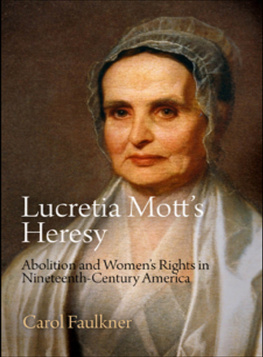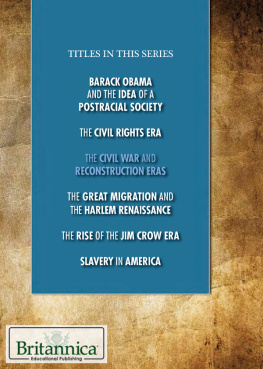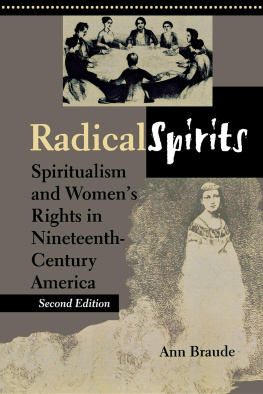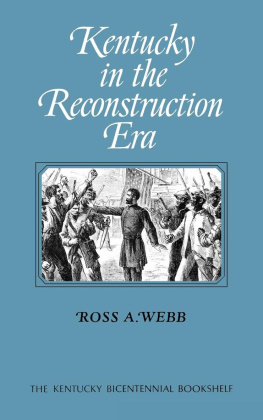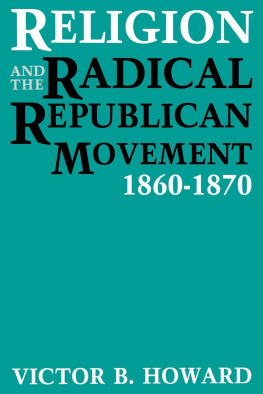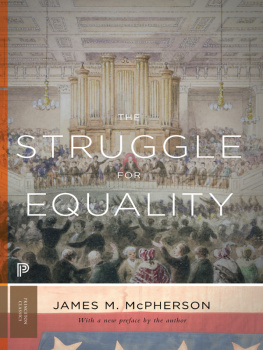Copyright 2004 University of Pennsylvania Press
All rights reserved
Printed in the United States of America on acid-free paper
10 9 8 7 6 5 4 3 2 1
First paperback edition 2006
Published by
University of Pennsylvania Press
Philadelphia, Pennsylvania 19104-4112
Library of Congress Cataloguing-in-Publication Data
Faulkner, Carol.
Womens radical reconstruction : the freedmens aid movement / Carol Faulkner.
p. cm.
Includes bibliographical references and index.
ISBN-13: 978-0-8122-1970-8 (pbk. : alk. paper)
ISBN-10: 0-8122-1970-8 (pbk. : alk. paper)
1. FreedmenUnited StatesHistory19th century. 2. African AmericansHistory18631877. 3. Reconstruction 4. Women social reformersUnited StatesHistory19th century. 5. RadicalismUnited StatesHistory19th century.
I. Title.
E185.2.F28 2003
973.714dc21
2003051227
For My Parents,
David and Joanne Faulkner
Introduction
In July 1863, Cornelia Hancock, a New Jersey Quaker, volunteered as a nurse for the Army of the Potomac at the Battle of Gettysburg. As the wounded soldiers recovered, Hancock looked for other ways to aid the Union cause. During the winter of 186364, she traveled to Washington, D.C., where hundreds of Northern women had gathered. In the District, women offered aid to former slaves gathered in camps around the city or worked as nurses in the local military hospitals. Hancock spent the rest of the war as a Union army nurse, but her winter in Washington inspired her postwar career. After observing the situation of former slaves in the city, Hancock formulated her ideas for the protection and elevation of freedpeople. She envisioned a government bureau, independent of the military, led by men with living souls in them large enough to realize that a contraband is a breathing human being capable of being developed.
In the same year, Josephine Griffing, an Ohio feminist acting as an agent for the National Freedmens Relief Association of Washington, D.C., petitioned Congress to give Northern and Western women responsibility for the care and education of these freedmen. Like Hancock, Griffing believed that emancipations success required continued government involvement. Although Hancock referred vaguely to anti-slavery persons, Griffings plan was more explicit. She suggested that Northern women, with government authorization, be deployed to provide relief to former slaves. During Reconstruction, both Hancock and Griffing saw much of their vision achieved, if only temporarily.
Hancock and Griffing were just two among many Northern white and black women who devoted themselves to freedmens relief during the Civil War and Reconstruction. This book examines the different ways these women tried to shape Reconstruction policy, and the methods they employed to aid former slaves. It also seeks to illuminate the lives of individual women in the freedmens aid movement, as their personal histories informed their strategies. Many of these women participated in the antebellum antislavery and womens rights movements, while others seized the new political and economic opportunities provided by the war and emancipation. As the proposals of Hancock and Griffing indicate, women in the freedmens aid movement viewed the federal government as a vehicle of reform. To advance the rights of both women and former slaves, women lobbied the government, worked as agents of the Freedmens Bureau, founded freedmens relief societies, toured the country raising money for freedmens aid, bought land to sell and rent to freedpeople, started common and industrial schools for freedpeople, and moved permanently to the South to act on their commitment to justice and equality for former slaves.
The successes and failures of these women are largely absent from most histories of the freedmens aid movement, which often portray the Yankee schoolmarm as the prototype of Northern womens activism. The efforts of white and black women appear in the records of aid societies and the Freedmens Bureau, in abolitionist and suffrage newspapers, and in published pamphlets and personal accounts. Though evidence tracing African American womens contribution is scant, black newspapers such as the Christian Recorder and the published writings of Frances Harper, Charlotte Forten, and others reveal the extent of black womens involvement in the freedmens aid movement.
In addition to revising the history of the freedmens aid movement, this examination of womens participation in freedmens relief shows the profound intersection of Reconstruction and womens reform. Women addressed issues that dominated Reconstruction politics, including race, labor, dependency, and political and civil rights. But rather than viewing these issues as separate from the womens rights movement, abolitionist-feminists maintained a broad definition of social reform that linked the struggles of former slaves with the struggles of women. During Reconstruction, women in the freedmens aid movement urged the federal government to include both women and African Americans in the national polity.
Black and white women in the freedmens aid movement articulated an ambitious platform for Reconstruction. Like the most radical of the Radical Republicans, they argued for universal suffrage, land confiscation Abolitionist-feminists believed that this assistance would enable freedpeople to become self-supporting citizens, while sustaining widows, mothers, children, the sick, the elderly, and others who could not survive without some aid. Finally, abolitionist-feminists asserted that womens participation in the war effort had earned them a right to participate in the reconstruction of the nation, both as administrators and as voters.
Many of the abolitionist-feminists goals failed, in part because most Republican politicians and Freedmens Bureau agents embraced a different vision of Reconstruction, one that prized economic freedom and independence over the repayment of social debts and equal rights. The male politicians and reformers who experimented with freedom in the South were principally concerned with reviving the Southern economy and creating a free class of African American laborers; they believed that a free-market economy would inevitably correct the racial and economic inequalities in Southern society. These policymakers asserted that diligent wage laborers could achieve upward mobility, and that only laziness and incapacity limited workers opportunities. Historians label this Northern worldview free labor ideology, a system of beliefs that pervaded their economy, society, and culture.
Free labor ideology shaped Northerners policies toward former slaves. Politicians, military officers, and reformers initially introduced wages and employment contracts into the existing plantation system. In 1865, Congress established the Freedmens Bureau to temporarily over-see the transition to free labor and protect freedpeoples interests. Though political and civil rights became an important component of the Republican plan for Reconstruction in the late 1860s, politicians presumed that once freedpeople had won these rights, they could assert them unaided. Most Americans stigmatized those who relied on others for their support, and they associated dependence with an ineligibility for the privileges of citizenship. To accept the help of the state was to be childlike, subordinate, and feminine. As a result, freedpeople could not seek help in claiming these rights without having those very rights called into question.


